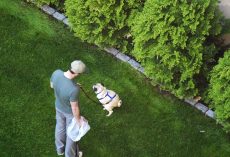Poor doggy. What does he have to do to get the point across? If you're doing something your pup hates and you're unaware try to be more aware of his body langauge and what he's trying to tell you. You may be surprised to learn that Fido is hungry and would like some food stat, or would rather be left alone as opposed to being forced to socialize with your five friends that just came over. Learn your pup's behavior and body language and you'll be able to read him a lot better! Check out more things you may be doing that Fido dislikes on mother nature network.
Dogs try to be our best friends, but boy do we ever make it difficult sometimes.
Using words more than body language
Dogs have evolved to be expert readers of the human body and can figure out what you’re thinking and feeling before you even realize you’re thinking and feeling it. But we can easily send mixed signals if we are only paying attention to what our mouths are saying and not what our bodies are saying. If you go to any beginning dog training class, you’ll see plenty of people saying one thing, doing another, and a confused dog trying to figure out what in the world is wanted of them.Hugging your dog
While you might love wrapping your arms around a furry canine friend, most dogs hate hugs. We as primates think hugs are awesome and express support, love, joy and other emotions through hugs. No matter your intentions with hugging, a dog is hardwired to view the act of hugging as you exerting your dominance.If you’re wondering if your dog hates your hugs, just pay attention to her body language when you go in for a cuddle. Does she tense up? Lean her head away from you? Avoid even a hint of eye contact? Lick her lips? Keep her mouth closed? Pull her ears back against her head? All of these are signs that a dog is uncomfortable.
Petting a dog’s face or patting her head
Yet most humans think that dogs like being patted on the head. The reality is that while many dogs will put up with this if it’s someone they know and trust, most dogs don’t enjoy it. If you really want to reward your dog for being awesome, don’t bang on their head, but give them a rub on their rear end right by the tail. They’ll thank you for it!Walking up to a strange dog while looking her in the eye
Either way, for most dogs, a stranger looking it right in the eye while approaching is not a comfortable situation.If you want to say hello to a new dog in a way that is comfortable for both of you, approach with your body angled slightly (not with your shoulders squared toward the dog), your eyes slightly averted, and speak quietly with a gentle voice. All these body language cues of friendship will help a dog understand you mean no harm. The dog might still want nothing to do with you, but at least you didn’t approach in a scary way that could cause a defensive or aggressive reaction.
Not providing structure and rules
Dogs want, need, and love having rules. You might think having strict rules makes life boring or unhappy for your dog. But dogs really want to know what’s what according to their leader. Rules make life a lot more predictable, a lot less confusing and a lot less stressful.Dogs thrive when they know where the boundaries are, and when you spend time enforcing consistent boundaries with positive rewards, you also are building up their trust in you as a leader. You’re setting up conditions for a very happy dog!
Forcing your dog to interact with dogs or people she clearly doesn’t like
Just like so many other social species, dogs have their favorite friends and their enemies. It is easy to see what other dogs — and people, for that matter — that a dog wants to hang out with and those with whom she’d rather not associate.What is possibly even worse, is that their trust in you as a protective leader is eroded, and they have an even more negative association with a park, a certain dog or person, or a general social setting. So do your dog a favor: read the body language she gives you when she doesn’t want to be around certain other individuals and don’t force it.
Going for walks without opportunity to explore and smell
There are walks, and there are walks. It’s definitely important to have a dog that knows how to walk obediently on a leash. However, it’s also important to allow a dog to have some time to explore her surroundings while walking obediently on a leash. Dogs see with their noses, and they place as much importance on their sense of smell as we humans place on our sense of vision for interpreting the world around us. It’s probably safe to say that dogs appreciate the smell of a tree trunk the way we appreciate a beautiful sunset. Dogs loathe not being able to take in their world for at least a few minutes a day, and too often we humans are focused on going on walks for the sole purpose of exercise or potty breaks.Keeping a tight leash, literally
Just as dogs are amazing at reading our body language, they’re amazing at reading our tension levels even through the leash. By keeping a tight leash on a dog, you’re raising the level of stress, frustration, and excitement for your dog, and conversely, for you. A dog that walks on a tight leash is more apt to bark or be reactive in even the most mild of social situations. But a dog that can walk on a slack leash is more likely to be calm. This is a difficult thing to master, and something the majority of dog owners can commiserate about, but it is so important to having pleasant walks with a relaxed dog.Being tense
The more stressed and wound-up you are, the more stressed and wound-up your dog is. And dogs, just like us, don’t like that feeling. You might roll your eyes, but the next time your dog is acting frustrated and tense, check in with yourself — have you been feeling that way for the last few minutes, for the last few hours, or the last few days? Your dog might just be acting as your mirror. If you need a reason to meditate, helping your dog calm down is a great one.Being boring
If your dog is making trouble — getting into boxes or closets, eating shoes or chewing on table legs — she’s basically showing you just how incredibly bored she is. Luckily, there is a quick and easy solution to this: training games. Teaching your dog a new trick, working on old tricks, playing a game of “find it” with a favorite toy, or going out and using a walk as a chance to work on urban agility, are all ways to stimulate both your dog’s mind and body. An hour of training is worth a couple hours playing a repetitive game of fetch in terms of wearing a dog out. While of course exercise and walks are important, adding in some brain work will make your dog happy-tired.Teasing
Don’t bark at a dog as you pass it on the street. Don’t wave or talk to a dog that is barking at you from behind a window or door. Don’t pull on a dog’s tail. It’s not funny to the dog and can lead to some serious behavioral problems — and, perhaps deservedly, you getting to sport some new dog-shaped teeth marks.









